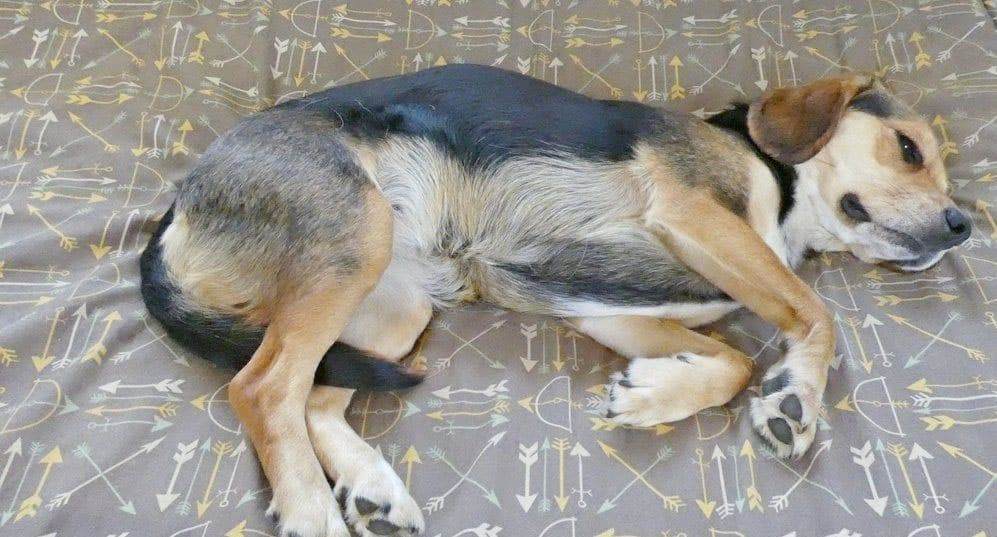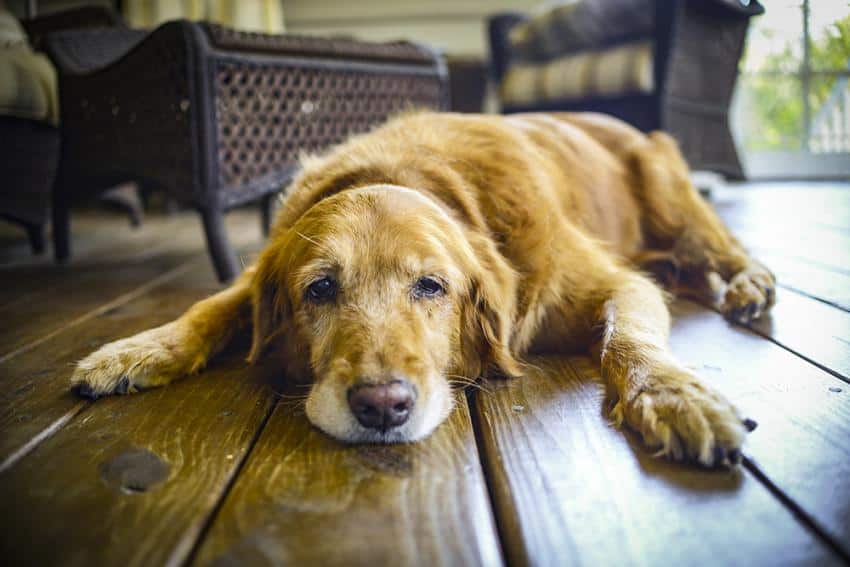Cancer is, unfortunately, a very common disease among canine pets. About 50% of older dogs (over the age of 10) get cancer at some point. This can be because of many reasons including genetics, breeding, and the fact that dogs tend to live a lot longer these days than ever before.
The fortunate thing is most of these cancers can be treated and possibly cured if they are caught early on. Just because your dog has cancer does not mean that they will die. There are a lot of procedures and treatments in place to help them overcome the disease.
However, before it gets too serious, there are many early warning signs you can look for that will tell you if your dog is getting sick. Below I have listed very common warning signs to look for.
Physical Signs
At A Glance:
Here is a quick glance at the physical symptoms that will be mentioned in the following article. For a deeper explanation about each of these symptoms keep scrolling.
- Swelling/Lumps
- Wounds that won’t heal
- Discharging Blood
- Unexplained Extreme Changes in Weight
- Seizures
- Bad Odors
1) Swelling or Lumps:
If you notice any swelling or lumps on your dog’s body that continues to grow or change, this is a warning that your dog could be in the beginning stages of cancer. You shouldn’t wait to observe any further developments of the masses growing on your pet.
You should immediately go to a vet or surgeon to have the masses looked at and make sure that it is not cancerous or dangerous in any other way.
Usually, the surgeon(s) will do a biopsy of the mass which involves removing it (if it is safe to do so) and testing it for signs of certain diseases or to see if it is benign or “safe”.
2) Unhealing Wounds
Wounds that seem to be persistent and unhealing can be another sign that your dog may have another underlying disease. A healthy dog will have wounds that begin to heal and dry out after a certain period of time. Even if they don’t do this on their own, they should after applying any topical or ingested antibiotics or ointments.
If they do not, you should take your pet to the vet so that they can examine the wound and tell you if there is any need to worry about a bigger cause or not. Areas that look extremely red and irritated can be an indicator of mast cell tumors which are a very common form of cancer in dogs.
3) Coughing/Sneezing Blood
Discharge of blood from the throat or nose (or any other part) of your dog is a sign of concern. Bloody sneezes, especially those where the blood only comes out of one nostril can be a sign of a few different types of cancers including nose or eye cancer.
Bloody coughs or discharges from the throat can be a warning sign of oral cancer or chest cancer. This can be very scary to see happen, but it does not necessarily mean your dog will not be able to recover.
If you witness either one of these signs you should immediately take your dog to their vet or to the nearest pet hospital so that they can be examined by a professional who can get to the root cause of their symptoms.
4) Unexplained Extreme Changes in Weight
If your pets seem to be gaining or losing weight extremely quickly than that should be another cause of concern. This symptom is actually a very common indicator of cancer in canines. This can be a sign of internal cancers that can be very hard to detect otherwise, often a tumor along the intestines or other parts of the gastrointestinal tract.
This is different from weight loss due to a diet change, or loss of appetite (which can be another sign and is discussed later in the article) if your pet seems to be eating and enjoying food as it normally does, and still exhibits these rapid changes, it is a sign that something is wrong.
5) Seizures
If your dog starts having seizures, especially when they are older and don’t have a history of seizures, it can be an indicator of cancer. In dogs, seizures look like uncontrollable and random bursts of activity.
This can include chewing motions, leg jerking, or a foaming mouth. If your dog exhibits any of these symptoms they should be brought immediately to the doctor’s office.
6) Bad Odors
If your dog starts to smell really offensive even with a regular grooming schedule, it could be a warning that there are internal problems. Some dogs who might have oral or throat cancer had extremely bad breath no matter how many times their mouths were cleaned or freshened.
Others who had gastrointestinal or bowel issues had a horrible smell constantly coming from their genital region because of the bacteria-filled masses and tumors that resided there.
If you or other people have begun to notice that your dog has been smelling worse than usual for no apparent reason, you should look into getting them a visit with a veterinarian as soon as possible.
Behavior Signs
At A Glance:
The following list includes all of the behavioral signs that may indicate that your dog has cancer. For an in-depth explanation of all of the listed symptoms keep scrolling
- Unwilling/Struggling to eat
- Unwilling/Struggling to go to the bathroom
- Lethargy
- Lameness/Stiffness
- Discomfort
1) Unwilling/Struggling to eat
If you are noticing that your dog has a loss of appetite or seems like they are hungry but having a hard time eating it could be a sign that it is time to take them to the vet.
Dogs who exhibit a seemingly random appetite loss could be signaling that there is some sort of nausea that they are feeling which is a common sign of canine cancer.
Those who seem to be struggling to eat could have tumors in their throat that is pressing on it and making it hard for them to swallow their food safely the way they normally would. Either way, this new behavior is very concerning and should not be taken lightly.
2) Unwilling/Struggling to Go to The Bathroom
Difficulty urinating could signal that there is pressure on the urinary system that could possibly be due to cancer. This can be the same for their bowel movements.
If you notice that they seem to be struggling to go poop more than usual or that it looks drastically different than it did the last time they went it can signal that something is irritating their bowels.
Occasional diarrhea is not something that should concern you, many dogs accidentally eat things that irritate their bowels but are not actually toxic or otherwise harmful.
You are looking for a sudden and persistent change in the way they go to the bathroom. If you do notice this change do not hesitate to get in contact with a medical professional.
3) Lethargy
As dogs get older and age it is very normal for them to gradually begin to slow down and become less energetic, this is not normally a sign of concern for pet owners. This can even include noticing that your dog is spending more time sleeping than it usually does.
However, if you notice a rapid and severe decline in your pet’s energy this could be a sign of cancer. It should be noted, however, that this symptom can indicate things other than cancer in canines, so you should not immediately jump to that conclusion and instead should go to see an animal physician to fully understand what is going on with your dog.
4) Lameness or Stiffness:
Cancer, especially one that affects bones, can cause lameness or stiffness due to pain in animals. If you notice that the way your dog walks suddenly changes or they begin to favor one leg more than another, it could be a sign that something is affecting the area that they are avoiding.
If they have just been injured in the area they aren’t using as they normally would, then this change in gait shouldn’t be too alarming because there is an obvious reason for it.
But, if it seems to come on for no apparent reason and get worse, you should not continue to wait for it to resolve itself and should seek medical help for your furry friend.
5) Discomfort
If your dog seems to be constantly in pain or just uncomfortable no matter how much you try to console them, it could be a very big warning that there is something seriously wrong with them.
If you notice them yelping more when you pick them up or go to pet them then you should start to think that things aren’t feeling the way they should for your canine.
You know how your dog generally acts, so if you see that things are changing and they are seeming to be distancing themselves and shying away from your touch out of fear of pain then you should take note of it and take them to the vet immediately.
Cancer prevention techniques
Some of you might be thinking that you don’t want to even wait until it gets to the point where your dog is exhibiting warning signs of internal issues before you take action. Luckily, there are a few prevention techniques that can help your dog live a healthy life and perhaps avoid cancer altogether!

1) Keep your animals fit and lean
Keeping your dog on a sustainable diet is one of the best ways to keep them from getting cancer as well as living longer because you don’t have to worry about them getting obese.
Fat in your dog can lead to inflammation and tumor growth. Your dog should also be getting regular exercise through walks or just time playing outside. Try not to encourage an idle lifestyle for your dogs and keep them moving and in shape.
2) Reduce their interaction with toxins
Chemical pesticides in lawn treatments, detergents, and household cleaners can lead to a greater risk of your dog getting cancer at some point in their life.
Even some flea and tick treatments can be detrimental to your dog’s health. It is important that you opt for more natural treatments or periodic detoxification so that your dog is not at risk of being poisoned.
3) Add healthy foods to your dog’s diet
There are a good amount of human foods that actually benefit your dog as well. For example, blueberries are very beneficial to your dog and their antioxidants can help fight against and kill cancer.
It is important that you do some research to find healthy alternatives to feed your dog in moderation and check to make sure the dog food you are giving them is not made with sub-par ingredients that can actually make their health worse.
4) Keep a regular check-up schedule
You should try your hardest to never miss one of your dog’s check-ups with their veterinarian. By keeping a set schedule you or their doctor are more likely to notice smaller changes faster and be able to respond to them before they turn into something serious.
During different life phases of your dog, they will need to see their vet more or less frequently. Usually, your vet will have a schedule they would like to stick to, try not to brush this suggestion off.
5) Give your dog vitamins or supplements
Along with feeding them better quality food, giving your dog healthy supplements or vitamins can help them build up a better immune system with the help of those powerful antioxidants.
Adding this step to their feeding routine really pays off just for the simple reason that it will keep them generally healthier. There are a couple of different forms that you can give our dog these supplements. The easiest one would probably be liquid form because you can just add it to their wet or dry food during meal time.
6) Keep Patience
It is important to note that you should not immediately feel helpless if your dog begins to exhibit one of these symptoms.
First, these can be signs for a variety of other diseases as well, so it is not always wise to jump straight to cancer without a medical opinion.
Second, even if it is cancer, there are a lot of treatments in place, many of them the same as human treatments, that can combat the disease and help your dog live a longer, happier life.
The treatments vary based on what type of cancer your pet has and how aggressive it is. Your veterinarian might recommend only one of the following treatments or a combination of them to make sure that they can attack the cancer as efficiently as possible the first time.
Cancer treatment options for dogs
The most common options for treatment include:
1) Surgery
This is usually the first thing that will be suggested for your pet by a medical professional. Especially if their cancer hasn’t spread around too much yet and they are relatively certain they can remove it all at once.
2) Chemotherapy
The doctors take powerful drugs and insert them inside the pet to attack the cancerous tumors and cells. Like humans, chemotherapy medication can be taken orally in pill form or intravenously
3) Radiation Therapy
This treatment often gets confused with chemotherapy but differs because chemo isn’t as targeted treatment as radiation is. Radiation takes the form of daily injections and once the medication is inside the body it is more localized in the area it affects.
4) Immunotherapy
This treatment is less common than the ones mentioned above, and less likely to be the first one recommended to you by your vet or pet oncologist. This treatment involves using the immune system to destroy cancer in your pet’s body. There is still a lot of research being done on this topic though.
If you and your canine do get to the point where you are going through treatment for cancer, it can get a little disheartening to watch them become weaker and less energetic as the chemotherapy or radiation does its job.
No one wants to watch their pet suffer through something like this, and dealing with the grief and trauma can be difficult. There are some ways to make it slightly easier and keep you and your pet in good spirits until things begin to turn around.
5) Be Honest About the Situation
It can be hard to watch your pet have to fight off disease, but that doesn’t mean you should try to sugarcoat it for yourself. Understand what your dog will be going through as they get treatment and medication.
Common side effects of cancer treatment include vomiting, low energy, and lack of appetite. Don’t go into this thinking things will be able to bounce back to how they were right away.
Your dog will need time to recover and setting those high expectations will only cause more disappointment for yourself. Have an in-depth conversation with the veterinarian or oncologist to make sure you are aware of what is to come and how to help your dog.
6) Group Therapy
Just like there are groups for humans with cancer, there are groups for people whose pets are fighting as well. Get around other people going through the same thing who can share in your questions and concerns and let you know that you and your dog are not alone.
If you don’t have a physical group you can attend in your area, you should try to do some research and find an online group that can offer you support over group chats or skype.
7) Have Fun with Your Dog
Even though your pet will have lower energy and won’t feel up to the same activities you used to do together, you shouldn’t completely stop having a good time.
When your dog is having good days maybe take them out to the backyard to play for a little while. On days that they seem a little down, make sure to give them extra love and attention and show your excitement that they are fighting and still here with you.
Pets can sense changes in emotion, so (when you can help it) don’t let your dog feel how worried or upset you might be.
8) Know when to Stop
This is a hard one, and a part of life that no one wants to face. There might come a time, however, when you should ask yourself if it is worth putting your dog through any more treatment.
This isn’t saying you should immediately give up on your dog if they get sick, but if they continue to get sick, or if treatment doesn’t seem to be helping anymore, it might be time to stop. Continuing on won’t be better for either one of you in the long run.
Your vet or oncologist will probably have a talk with you when they start to see signs that things aren’t working anymore, but ultimately that decision is up to you.

Conclusion
Hopefully, you never have to encounter a time where you have to worry about looking for symptoms in your four-legged friend. If you follow these prevention tips as well as any others your vet might tell you, your dog should be able to live a happy and healthy life.
It is important though, to have this information in the back of your head and constantly be aware of any sudden changes in your dog’s behavior, even those that don’t seem to be too alarming. A quick response is key to getting your canine friend back on track!
References
Table of Contents




